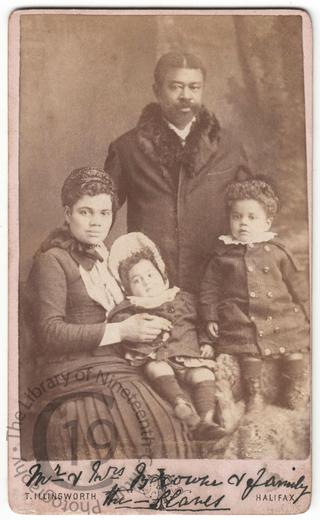
Mr and Mrs Brown and family
A carte-de-visite portrait of the former slave and Baptist minister Benjamin William Brown, who first came to England in or about 1881 and was still here some 30 years later. He toured the country singing Negro spirituals and giving a lecture entitled Scenes from Slaveland, later published as Life in Slaveland. He is seen here with his wife Jane and two of their children.
According to a report published in the Western Mail (27 June 1881), special services had recently been held at Wood Street Congregational Chapel in Cardiff. ‘On Sunday afternoon a freed slave from America delivered a Gospel address at Wood-street Chapel, and a collection made for the purpose of assisting him to build a chapel in his native place resulted in the sum of £5 9s. In the morning and the evening the Rev. W. Watkiss preached, and Mr Brown and his sister [sic] rendered several interesting Gospel melodies. At the evening service about 3,000 persons were present. To-night (Monday) the ex-slave gives an account of his own experiences.’
The Browns were still in England the following spring. On 23 March 1882 the Western Daily Press published an account of a meeting at Wotton-under-Edge in Gloucestershire. ‘On Tuesday the promoters of the Gospel Temperance Mission and Blue Ribbon Army in this town organised a tea meeting and entertainment at the Baptist Schoolroom. Nearly 200 partook of the tea together, and afterwards formed in procession and marched round the town, preceded by a handsome new banner, bearing the words in gold letters “Blue Ribbon Army Gospel Temperance Mission.” The entertainment afterwards was entitled “Scenes in Slave Land,” and consisted of some negro hymns and melodies sung by Mr and Mrs Brown, ex-slaves, and were accompanied by Miss Skelton, who presided at the harmonium. Mr Brown, who was for 19 years a slave, also gave some sketches of slave life, as illustrated by his own experience, some of the reminiscences of his boyhood proving very attractive to the young people present. The Rev. W. Davy, who presided, offered some appropriate remarks and that they were anxious to make the meeting a practical one, and invited all present to join the temperance army. Mr W. Rich proposed and Mr Bradfield seconded, a vote of thanks for the entertaining lecture, which was carried with acclamation. There was a large audience.’
A month later a Hereford newspaper reported that ‘On Thursday evening in last week, Mr and Mrs Brown, who described themselves as “Singing Pilgrims,” ex-slaves from the United States, again gave an entertainment at the Independent Chapel. Their object is to obtain a fund for improving the social, moral, and religious character of their own race. The programme comprised a number of quaint negro melodies, and considerable interest was manifested in an address by Mr Brown’ (Hereford Times, 8 April 1882).
On 24 January 1885 the Huddersfield Chronicle reported that a few days earlier at St Stephen’s Church in Rashcliffe ‘Mr B.W. Brown, ex-slave from Baltimore […] gave a short but interesting address on “Scenes in Slaveland,” which was listened to with great attention.’
A report in the Herts Advertiser on 23 March 1889 gives some idea of the content of the ‘Scenes in Slave-land’ lecture given by ‘The Rev. B.W. Brown, ex-slave and coloured minister’ at the Park Street Chapel in Hatfield: ‘he was born in slavery, and remained a slave until the emancipation of 1863. Several times during that period he tried to make his escape, but was captured and brought back each time. He gave to the company a minute account of his life on the plantation, highly delighting his audience with a description of an old log cabin, where the little negro children who were too young to work, were lodged under the superintendence of an old negro lady. He next described the horrors of the slave markets at Baltimore and New Orleans, and concluded by saying that although slavery had been abolished in the United States and a great many other places, it was still carried on in Africa.’
A book based on the lecture, titled Life in Slaveland, seems to have run through many editions.
Benjamin W. Brown, an ‘Evangelist Preacher’ aged 49, and his wife Jane, aged 36, appear on the 1891 census, living at West Ham in East London with their children Bertie (8), Fanny (6), Ernest (4), and Stanley (2). All of them were born at Baltimore in Maryland. Twenty years later, at the time of the 1911 census, Benjamin William Brown was living at 15 Garfield Road in Wimbledon with another son, Charles Haddon Spurgeon Brown, aged 19. Jane and the other children were elsewhere on the night of the census. According to their census return, the couple had had twelve children, of whom seven were still living. Benjamin described himself as a ‘Home Missionary’ engaged in ‘Private Evangelisation,’ and this time gave his place of birth a little more specifically as ‘Kent Island, Queen Anne’s County, Maryland.’ His son Charles, born in Leytonstone, gave as his profession ‘Assistant Evangelist.’
I haven't found any record of the Reverend Brown's death in the United Kingdom, so for the time being I'm presuming that he returned to the US in his final years.
Photographed by Thomas Illingworth of Halifax in West Yorkshire.
Code: 126634




